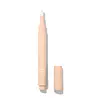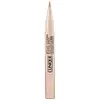What's inside
What's inside
 Key Ingredients
Key Ingredients

 Benefits
Benefits

 Concerns
Concerns

 Ingredients Side-by-side
Ingredients Side-by-side

Water
Skin ConditioningDimethicone
EmollientButylene Glycol
HumectantTriethylhexanoin
MaskingOctyldodecanol
EmollientMica
Cosmetic ColorantLauryl PEG-9 Polydimethylsiloxyethyl Dimethicone
Skin ConditioningSilica
AbrasiveMagnesium Sulfate
Diglycerin
HumectantDisteardimonium Hectorite
StabilisingPhenoxyethanol
PreservativeLauryl PEG-10 Tris(Trimethylsiloxy)Silylethyl Dimethicone
EmulsifyingPropylene Carbonate
SolventAluminum PCA
AstringentTriethoxycaprylylsilane
Hexylglycerin
HumectantCaprylyl Glycol
EmollientDisodium EDTA
Dipropylene Glycol
HumectantSodium Citrate
BufferingTocopherol
AntioxidantSodium Hyaluronate
HumectantSodium Alum
AstringentCI 77891
Cosmetic ColorantIron Oxides
Water, Dimethicone, Butylene Glycol, Triethylhexanoin, Octyldodecanol, Mica, Lauryl PEG-9 Polydimethylsiloxyethyl Dimethicone, Silica, Magnesium Sulfate, Diglycerin, Disteardimonium Hectorite, Phenoxyethanol, Lauryl PEG-10 Tris(Trimethylsiloxy)Silylethyl Dimethicone, Propylene Carbonate, Aluminum PCA, Triethoxycaprylylsilane, Hexylglycerin, Caprylyl Glycol, Disodium EDTA, Dipropylene Glycol, Sodium Citrate, Tocopherol, Sodium Hyaluronate, Sodium Alum, CI 77891, Iron Oxides
Dimethicone
EmollientWater
Skin ConditioningIsopentyldiol
HumectantPolymethylsilsesquioxane
Trisiloxane
Skin ConditioningMethyl Trimethicone
Skin ConditioningPentaerythrityl Tetraethylhexanoate
EmollientPhenyl Trimethicone
Skin ConditioningTribehenin
EmollientPEG-10 Dimethicone
Skin ConditioningHydrogenated Polyisobutene
EmollientSilica
AbrasiveLecithin
EmollientPolysilicone-11
Lauryl PEG-9 Polydimethylsiloxyethyl Dimethicone
Skin ConditioningCaffeine
Skin ConditioningDimethicone/PEG-10/15 Crosspolymer
Dimethicone/Vinyl Dimethicone Crosspolymer
Skin ConditioningPropylene Carbonate
SolventTriethoxycaprylylsilane
Alumina
AbrasiveTriethyl Citrate
MaskingSodium Chloride
MaskingDisteardimonium Hectorite
StabilisingLaureth-7
EmulsifyingSodium Hyaluronate
HumectantDipropylene Glycol
HumectantSodium Dehydroacetate
PreservativeDisodium EDTA
Phenoxyethanol
PreservativeCI 77891
Cosmetic ColorantCI 77491
Cosmetic ColorantCI 77492
Cosmetic ColorantCI 77499
Cosmetic ColorantCI 77163
Cosmetic ColorantMica
Cosmetic ColorantDimethicone, Water, Isopentyldiol, Polymethylsilsesquioxane, Trisiloxane, Methyl Trimethicone, Pentaerythrityl Tetraethylhexanoate, Phenyl Trimethicone, Tribehenin, PEG-10 Dimethicone, Hydrogenated Polyisobutene, Silica, Lecithin, Polysilicone-11, Lauryl PEG-9 Polydimethylsiloxyethyl Dimethicone, Caffeine, Dimethicone/PEG-10/15 Crosspolymer, Dimethicone/Vinyl Dimethicone Crosspolymer, Propylene Carbonate, Triethoxycaprylylsilane, Alumina, Triethyl Citrate, Sodium Chloride, Disteardimonium Hectorite, Laureth-7, Sodium Hyaluronate, Dipropylene Glycol, Sodium Dehydroacetate, Disodium EDTA, Phenoxyethanol, CI 77891, CI 77491, CI 77492, CI 77499, CI 77163, Mica
Ingredients Explained
These ingredients are found in both products.
Ingredients higher up in an ingredient list are typically present in a larger amount.
Ci 77891 is a white pigment from Titanium dioxide. It is naturally found in minerals such as rutile and ilmenite.
It's main function is to add a white color to cosmetics. It can also be mixed with other colors to create different shades.
Ci 77891 is commonly found in sunscreens due to its ability to block UV rays.
Learn more about CI 77891Dimethicone is a type of synthetic silicone created from natural materials such as quartz.
What it does:
Dimethicone comes in different viscosities:
Depending on the viscosity, dimethicone has different properties.
Ingredients lists don't always show which type is used, so we recommend reaching out to the brand if you have questions about the viscosity.
This ingredient is unlikely to cause irritation because it does not get absorbed into skin. However, people with silicone allergies should be careful about using this ingredient.
Note: Dimethicone may contribute to pilling. This is because it is not oil or water soluble, so pilling may occur when layered with products. When mixed with heavy oils in a formula, the outcome is also quite greasy.
Learn more about DimethiconeDipropylene Glycol is a synthetically created humectant, stabilizer, and solvent.
This ingredient helps:
Dipropylene glycol is technically an alcohol, but it belongs to the glycol family (often considered part of the ‘good’ alcohols). This means it is hydrating and gentle on skin unlike drying solvent alcohols like denatured alcohol.
As a masking agent, Dipropylene Glycol can be used to cover the smell of other ingredients. However, it does not have a scent.
Studies show Dipropylene Glycol is considered safe to use in skincare.
Learn more about Dipropylene GlycolDisodium EDTA plays a role in making products more stable by aiding other preservatives.
It is a chelating agent, meaning it neutralizes metal ions that may be found in a product.
Disodium EDTA is a salt of edetic acid and is found to be safe in cosmetic ingredients.
Learn more about Disodium EDTADisteardimonium Hectorite comes from the clay mineral named hectorite. It is used to add thickness to a product.
It can also help stabilize a product by helping to disperse other ingredients.
Hectorite is a rare, white clay mineral.
Learn more about Disteardimonium HectoriteLauryl PEG-9 Polydimethylsiloxyethyl Dimethicone is a type of silicone.
Mica is a naturally occurring mineral used to add shimmer and color in cosmetics. It can also help improve the texture of a product or give it an opaque, white/silver color.
Serecite is the name for very fine but ragged grains of mica.
This ingredient is often coated with metal oxides like titanium dioxide. Trace amounts of heavy metals may be found in mica, but these metals are not harmful in our personal products.
Mica has been used since prehistoric times throughout the world. Ancient Egyptian, Indian, Greek, Roman, Aztec, and Chinese civilizations have used mica.
Learn more about MicaPhenoxyethanol is a preservative that has germicide, antimicrobial, and aromatic properties. Studies show that phenoxyethanol can prevent microbial growth. By itself, it has a scent that is similar to that of a rose.
It's often used in formulations along with Caprylyl Glycol to preserve the shelf life of products.
This ingredient is a solvent. It helps dissolve active ingredients and alter the texture of products.
Propylene Carbonate is commonly used in makeup and with clay, such as montmorillonite or bentonite.
Studies show this ingredient to be safe for cosmetics. When it is undiluted, it can cause skin irritation. (It is always diluted in skincare and makeup). This ingredient is water-soluble.
Propylene Carbonate is created from propylene glycol and carbonic acid.
Learn more about Propylene CarbonateSilica, also known as silicon dioxide, is a naturally occurring mineral. It is used as a fine, spherical, and porous powder in cosmetics.
Though it has exfoliant properties, the function of silica varies depending on the product.
The unique structure of silica enhances the spreadability and adds smoothness, making it a great texture enhancer.
It is also used as an active carrier, emulsifier, and mattifier due to its ability to absorb excess oil.
In some products, tiny microneedles called spicules are made from silica or hydrolyzed sponge. When you rub them in, they lightly polish away dead skin layers and enhance the penetration of active ingredients.
Learn more about SilicaSodium Hyaluronate is hyaluronic acid's salt form. It is commonly derived from the sodium salt of hyaluronic acid.
Like hyaluronic acid, it is great at holding water and acts as a humectant. This makes it a great skin hydrating ingredient.
Sodium Hyaluronate is naturally occurring in our bodies and is mostly found in eye fluid and joints.
These are some other common types of Hyaluronic Acid:
Learn more about Sodium HyaluronateTriethoxycaprylylsilane is a silicone used to bind and stabilize ingredients.
As an emulsifier, it helps prevent ingredients from separating. This can help elongate the shelf life of products.
Triethoxycaprylylsilane is often used to coat mineral sunscreens ingredients to help give a better feel. It also helps reduce oxidative stress in sunscreens.
Learn more about TriethoxycaprylylsilaneWater. It's the most common cosmetic ingredient of all. You'll usually see it at the top of ingredient lists, meaning that it makes up the largest part of the product.
So why is it so popular? Water most often acts as a solvent - this means that it helps dissolve other ingredients into the formulation.
You'll also recognize water as that liquid we all need to stay alive. If you see this, drink a glass of water. Stay hydrated!
Learn more about Water